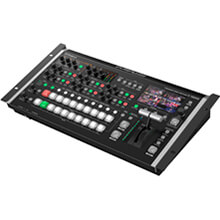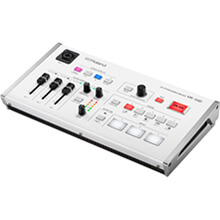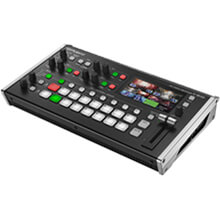
9 Things You Should Know About Roland Video Switchers
By Kriss Hampton-Joyce | Chief Technical Officer, Holdan
There’s no getting away from it, the market is rather well saturated with video switchers, from super compact HDMI units that are extremely wallet friendly, to fully IP-based behemoths that support multichannel 4K. There are plenty of options for most budgets, production requirements and operator experience. So, when it when it comes to looking at the right switcher for the job, it can be somewhat daunting to get to know why you should buy into one brand over another. This is exactly what I want to outline in this article about Roland switchers, so here are 9 key features and benefits that you might find useful, depending on the type of production.
1. Active Scaling
There are many vision mixers available that will automatically scale your input video source to fit that of the project that the mixer is set to work in. For example, if you’re working in a 1080p project and you feed in a 720p video signal, it will be upscaled to 1080p. However, this is typically done using passive scaling, especially at the more budget-friendly end of the market. This means that you have no control other than setting an overall resolution/frame rate for all scalers as a collective.
With Roland switchers you have complete control over those individual scalers. Perhaps you want to overscale an input source to do a digital crop, or maybe you want to reduce the overall size of the source video and shift it over to one area of the frame, so it better fits a multilayer effects composition. You can even flip the horizontal and vertical axis. Having individual control over each scaler gives you so much more flexibility, and at the very least if you just want to conform inputs to the master resolution you can do so.
2. Audio Isn’t Just an Afterthought
There really aren’t many vision mixers that will allow you to run a complete production without additional audio kit. Roland’s pedigree in the professional audio space means that their video switchers generally have the audio manipulation tools that sound technicians would expect from a dedicated audio desk, and then some. Taking the newly-introduced V-160HD as an example (which has a 40-channel digital audio mixer) each channel within its mixer has access to delay, reverb, high pass filter, echo canceller, noise gate, de-esser, compressor, EQ, multi-band compressor, anti-feedback filter, limiter - even auto mixing.
The auto mixing ability really comes in handy for smaller productions where perhaps the operator is part of the production and is also on camera presenting. They really need their production kit to be as easy to manage as possible, so they can concentrate on the content. The VR-1HD is a compact, three channel HDMI switcher perfect for interviews and small-scale podcasts. You can assign an XLR input to one of those HDMI inputs (which would be feeding in the output of a camera) so when presenter one is talking their closeup camera is automatically made live, same goes for when presenter two talks, and if they are both talking the third shot is made live which is a wide shot showing both presenters.
Audio connectivity is key too; if you don’t want to use a dedicated audio desk then you’ll need the ability to connect your professional microphones into the system. Pretty much any Roland switcher that has XLR audio inputs can supply 48V phantom power, so you can use professional condenser microphones without additional pre-amps - something you really don’t see often on vision mixers. The Roland VR-50HD MKII for example has four XLR inputs (along with ¼-inch jack, RCA, and support for embedded HDMI and SDI audio) with physical controls for those audio channels that are akin to those on a mini audio mixing desk. The operator can happily vision mix and ride audio faders from the one desk/position. You can even connect Bluetooth audio sources to the V-160HD.

3. Multiformat Support
Roland is very good at combining multiple input types in the one production unit. If you’re regularly working with different inputs, it’s good to know that you’ve got your bases covered without having to convert – this is what Roland calls a ‘multiformat’ switcher. These models typically have a mixture of SDI, HDMI, RGB/Component, Composite and DVI video inputs that you can assign. The V-160HD, for example, is an 8-channel switcher where you physically have 8 HDMI and 8 SDI inputs to mix and match from – and any of these input ports can be assigned to channels on the main bus.
4. PTZ Camera Control
Roland has multiple models in their vision mixing line-up that have integrated PTZ (Pan, Tilt, Zoom) camera control. The V-160HD can control up to 16 PTZ cameras (with support for multiple brands, which can be mixed and controlled within the same project) connected to the LAN. Without any additional hardware you can manually control the PTZ cameras directly from the switcher itself.
You can access more advance controls by using the supporting software on a laptop, or the app installed on a tablet connected to the switcher. You can even include these PTZ camera commands as part of a macro, making it possible to pre-programme complex action lists that you can fire off at the push of a button. Ultimately it makes pulling off dynamic shows much easier with just the one operator at the helm.
5. Intelligent Tally
For the Roland switchers that have PTZ camera control built in, tally information is also sent to the camera. This even works with different brands of PTZ cameras at the same time. So, if your PTZ camera has a tally light built-in, you will have a working tally system straight out of the box.
If you’re not using PTZ cameras, there are of course other ways in which you can set up tally. The most basic is using the physical Tally/GPIO port on the back of the switcher. Later models, including the V-160HD, have an innovative feature called Smart Tally. When the V-160HD is on a local area network you can access it via a web browser from any computer/smartphone that’s on that same network. A link opens a new page for every input on the switcher (input 1 has its own link/page, input 2 has its own link/page etc) – each link opens a webpage that has the name of that source and will illuminate full screen green or red when that source is on preview or programme.
If the LAN you’re using has wireless too, then you can effectively use any smartphone or tablet mounted on a camera (or anywhere the operator/presenter can see it) and with no extra cabling get a working tally system – there’s no configuration required, and it of course doesn’t matter what cameras you’re using.

6. Automation
Macros are an incredibly useful tool for pulling off multiple actions almost instantaneously at the push of a button, and of course this functionality is available with a lot of the Roland models. Where this gets interesting is with the V-160HD, as this has the newly developed sequencer which allows you to create a sequence of up to 1000 steps (each step can recall a preset or macro) to build incredibly complex scenes and transitions.
It's great to see that Roland are cascading these innovations into other products too - for example the cheaper V-8HD switcher will soon benefit from a free-of-charge, feature-rich firmware update.
7. Hybrid Event Ready
Hybrid events aren’t entirely new, but the pandemic has made it the new normal for in-person events to be blended with remote participation. A video switcher that can cater for hybrid events needs to have the ability to send different mixes to different outputs. For example, to drive a screen at the physical event for the in-person audience, drive a confidence monitor for the on-stage presenters, as well as live stream the programme to remote participants. There are several Roland switchers that have this capability.
Models such as the V-160HD have live streaming capabilities built in with a USB output. You simply connect the USB output to a laptop or PC and the programme (or any other selectable buses) appears just like any plug-n-play webcam, with which you can go live using your preferred platform.
With the V-160HD you can mix and route an auxiliary channel to any of the outputs. There is a Sub Programme mix too, which is essentially the Programme output without Picture-in-Picture key and DSK layers. The Multiview, 16 Input-View, 16 Still-View, along with Programme and Preview are all routable to separate outputs. When it comes to managing a hybrid event, you want complete flexibility in what you send where and Roland gives you that.
8. HDCP
HDCP (High-bandwidth Digital Content Protection) is a form of digital copyright protection designed to prevent piracy when outputting content from one device to another, typically using HDMI or DVI. For example, when you connect a Blu-ray player (or to be more modern, a smart device, like a Google Chromecast) to your TV it will first check to see if that TV is HDCP compliant. If the TV does have a HDCP license, then the Blu-ray player will happily pass on the audio/video signal as expected. If it is not HDCP compliant, you’ll see a blank screen, or an error message. This can be problematic when it comes to production switchers that use HDMI or DVI inputs. Unlike most manufacturers, Roland do offer models that support HDCP, so you can play content from computers, DVD players, any media player really. If you don’t need this feature, you can simply turn HDCP off.
9. Remote Record Trigger
The most recent switchers from Roland can trigger recording on an Atomos monitor/recorder over HDMI. If you need a calibrated monitor with proper video monitoring tools, Atomos have a great range of options, from 5-inch portable models up to 24-inch production units. Most Atomos (bar two) support recording to SSD drives, so it’s a nice way to streamline your setup, combining your monitor with your recorder.
It’s also worth noting that some of the Roland switchers feature a built-in screen on the desk which you can toggle between multiviewer and any of the main buses – so even at a push, if you wanted to be super streamlined you could use the switcher screen as the multiviewer and, say, an Atomos Ninja V 5-inch recorder to display and record your programme.
For more information please contact our Sales Desk:
+44 (0)1457 851000 | sales@holdan.co.uk.
27 Nov 2025
PTZOptics: Versatile, Professional PTZ Solutions for Every Production Environment
19 Nov 2025
Expanding Possibilities: Introducing Sonnet Technologies’ High-Performance Solutions for Apple and Professional Workflows
14 Nov 2025
Take Command of Your Creativity: Meet the Elgato Stream Deck Family
26 Sep 2025
Lumens VC-TR60A PTZ Camera Earns Microsoft Teams Certification







